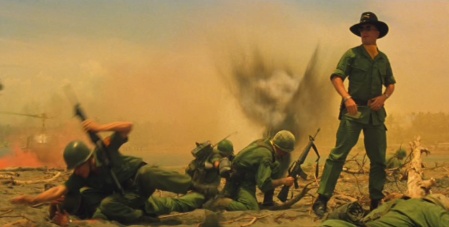For this piece of work I am going to explain what both techniques, Mise-en-scene and Semiology are, how they are used, why they are used and when they are used. Then I will explain using three different film stills.

This scene is from ‘Apocalypse Now’, it has Rules of Thirds, and is a long shot (LS). The use of a LS in this scene is very well done as it shows everything that is going on. The subject is obvious in this scene he has neat, ironed trousers and is standing over three other soldiers. Even the littlest details can tell us a lot about the scene. We receive a lot of information from this scene and the rule of thirds plays a big part in that, the rule of thirds is when there is a three by three grid over the picture and everything of importance is positioned on the lines for example the main subject which is the man standing up. The helicopter is in the distance which shows depth and implies that the environment is quite large. And after all that most of the focus is still on the main subject.
The Mise-en-scene was very specific in this scene so that us as the audience decode it. An example of this is the explosion in the background, we decode this and it tells us that there is a war taking place. The talent on the right is standing up for a reason, it shows he is important. By having him stand up in the middle of the battle lets the audience decode and realise that he is somewhat of a figure for these men, a captain there to lead and to boost the morale of his troop by showing no fear.

This is a scene from ‘Lawrence of Arabia’ and contains a lot of the rules of composition. It is a wide shot and uses rule of thirds. Rule of thirds is the positioning of the subject/subjects, if there was a three by three grid everything of interest would be somewhere on the lines which makes it easier to understand. It also has both characters looking at the black figure approaching them which indicates that it is significant because in the actual film the character on the left does not take his eyes off him while walking. And finally it uses leading lines , the leading lines start at the two characters in the foreground and moves up towards the black figure in the middle. The two closest characters almost frame the black figure.
Semiology is used well in this scene. Semiology is the science of signs, this could be colour, images and more. So by making the figure hidden in the shadows, lets us as the audience decode it as him being mysterious, powerful as his identity is unknown or even evil as connotations of black are, death, dark and evil. Another thing is the surroundings, there isn’t any therefore where did this dark figure come from and who could he be?

This is a very powerful scene from ‘Schindler’s List’ this is a long shot, I think that a LS was a really clever choice for this scene as it shows the whole character and their surroundings which ties In with the semiology used.
The colour red is used to draw attention to the little girl, the denotation is that the girls coat is red in a black and white film. The connotations of the colour red is death, blood, life and love. All these relate to this scene as they are all surrounding the little girl, other people’s suffering and her hope so without the long shot we could not have seen the suffering in the background we would not have put the girl into context therefore not feeling the same way.
These techniques were very interesting things to learn, I feel I understand how, why and when to use both Mise-en-scene and Semiology when producing my own project and the impact it can have on someone as a viewer.
Oct 4 – Jenni B – this is obviously not complete, and I will re comment when finished, but interim – explain what you are saying, what is Rule of Thirds etc. Do not presume audience knows what you are talking about. You must tag and you must unit number each post
LikeLike
Jenni – you haven’t really told us what Semiology is, you have talked more about the composition. Let’s discuss this in your 1-2-1 after sdsw
LikeLike